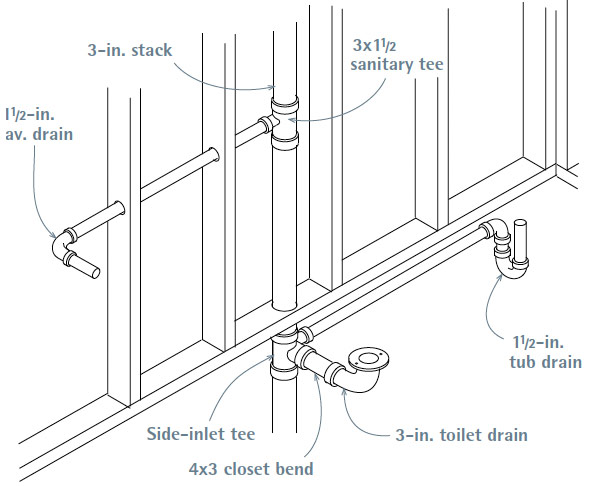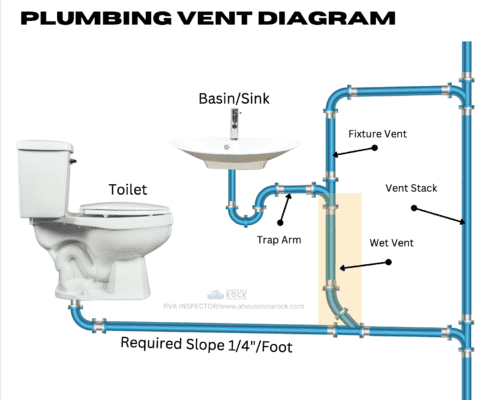Why Adequate Ventilation is Vital for Plumbing Systems
Why Adequate Ventilation is Vital for Plumbing Systems
Blog Article
Just how do you actually feel with regards to What Is a Plumbing Vent and Why Is It Important?

Appropriate air flow in plumbing systems is frequently forgotten, yet it is vital for keeping the performance and safety of your home's pipes. Air flow helps control air pressure, stop the accumulation of harmful gases, and ensure the effective removal of waste. In this guide, we will explore the significance of proper pipes air flow, how it functions, and the advantages it offers your plumbing system.
Comprehending Air Flow in Pipes
Ventilation in plumbing describes the network of pipes that enable air to stream through the drainage system. These vents serve multiple objectives, including controling atmospheric pressure within the pipelines, stopping sewage system gases from going into the home, and aiding in the smooth flow of wastewater.
Exactly How Ventilation Functions in Plumbing Systems
Atmospheric Pressure Policy
Proper air flow preserves balanced atmospheric pressure within the pipes system. When water streams through pipes, it displaces air. Without ample ventilation, this displacement can develop adverse stress, causing reduce drains pipes or siphoning of water from traps, which can create undesirable odors to permeate into the home.
Avoiding Sewer Gas Build-up
Among the most important functions of pipes vents is to avoid sewage system gases, such as methane and hydrogen sulfide, from accumulating within the home. These gases can position significant health threats and are highly flammable. Vent pipelines enable these gases to run away safely outdoors.
Aiding in Waste Elimination
Ventilation aids in the effective removal of wastewater by stopping airlocks in the drainage system. When air can flow freely through the vents, it enables water and waste to move efficiently via the pipelines, decreasing the threat of clogs and back-ups.
Kinds Of Pipes Vents
Main Stack Vent
The primary stack vent, likewise called the vent pile, is the key vent in a pipes system. It expands from the main drainpipe align through the roofing, allowing gases to leave and fresh air to go into the system.
Branch Vent
Branch vents attach to the major stack vent and offer private components, such as sinks, commodes, and showers. These vents make certain that each component has appropriate ventilation to function effectively.
Air Admittance Valve (AAV).
An Air Admission Shutoff (AAV) is a one-way valve that allows air to go into the pipes system without the requirement for a traditional air vent pipeline expanding with the roofing. AAVs are generally utilized in renovations or locations where mounting a conventional air vent is impractical.
Indications of Poor Ventilation in Plumbing.
Slow Draining Fixtures.
If your sinks, bathtubs, or commodes are draining pipes gradually, maybe an indication of poor ventilation. Poor air flow can create a vacuum cleaner result, making it difficult for water to drain pipes correctly.
Gurgling Seems.
Gurgling sounds originating from drains are typically an outcome of air being sucked through water catches as a result of unfavorable pressure in the pipes. This is a clear indicator of not enough ventilation.
Undesirable Smells.
Drain odors inside your home are a warning that your plumbing system is not effectively aerated. This can indicate that sewage system gases are not being sufficiently vented outside, leading to possibly unsafe problems.
Usual Air Flow Blunders.
Insufficient Vent Sizing.
Using undersized vent pipelines can cause poor air circulation and pressure inequalities in the system. It's important to use vents that fulfill the certain requirements of your pipes system.
Improper Vent Positioning.
Placing vents also far from the components they offer can reduce their effectiveness. Appropriate placement guarantees that air can stream openly and effectively via the system.
Ignoring Code Requirements.
Building regulations supply particular standards for plumbing air flow. Disregarding these codes can lead to a system that fails to function appropriately and might lead to expensive repairs or health hazards.
Advantages of Correct Ventilation.
Boosted System Effectiveness.
Correctly aerated pipes systems operate extra efficiently, with fewer clogs, faster draining, and much less pressure on the pipes. This efficiency expands the life expectancy of the plumbing system.
Improved Air High Quality.
By stopping sewage system gases from entering your home, proper air flow adds to better interior air top quality, making your living environment healthier and much more comfy.
Preventing Water Damage.
Adequate air flow aids protect against water from being siphoned out of traps, which can result in sewage system gases entering the home and creating water damage gradually.
Steps to Guarantee Appropriate Ventilation.
Consulting Pipes Codes.
Constantly consult regional plumbing codes when making or customizing your plumbing system. These codes supply the necessary standards for correct airing vent and guarantee your system fulfills safety and security requirements.
Normal Examination and Upkeep.
Routine examinations can help determine potential ventilation concerns before they come to be significant issues. Upkeep tasks, such as cleansing air vent pipelines and checking for clogs, are necessary for keeping the system in good working order.
Professional Installment.
For new installments or major adjustments, it's a good idea to hire an expert plumbing technician. They have the proficiency to ensure the ventilation system is correctly created and mounted according to code.
Final thought.
Correct ventilation is a vital part of any type of plumbing system, making sure that it functions efficiently and securely. By comprehending the relevance of air flow, acknowledging the indicators of bad air flow, and taking actions to preserve your system, you can avoid expensive problems and safeguard your home's air high quality.
Understanding the Role of Your Plumbing Vents in the Drainage System
The plumbing system in your home is more than just the kitchen sink, toilet, and bathroom. Some problems that arise within home plumbing are hard to detect because homeowners may not understand potential causes.
One part of the plumbing system that could cause you endless problems is the venting. The drain lines that run through your home and drain wastewater need proper venting to function properly. Faulty plumbing vents can lead to several problems that require the expertise of a plumber to check them out. Before finding experienced plumbing services, there are a few things to learn about plumbing vents.
Why vents are vital
Vents in the plumbing system lead to an outside area such as the roof or the back. The function of these vents is to keep sewer gases away from the drain pipes. They also establish seals in the drainage pipes that prevent the sucking back of waste gases into the home. Venting in the plumbing system also allows oxygen to get into the drainage system, which is an essential component in the breakdown of waste matter. The vents also ensure that the air pressure within the drainage system remains balanced, facilitating the flow of wastewater.
Possible problems
When the plumbing vents are problematic, one of the consequences is imbalanced water levels in the toilet. If you notice that the levels in the toilet bowl rise and fall all the time, then there may be something wrong with the vents.
Another issue is air bubble formation within the toilet. In most cases like these, the drain pipes are not receiving enough air. Lack of air pressure equalization is what leads to water flow problems. If you come across such issues in your home, make sure you call professional plumbers, such as the ones from Perfection Plumbing & Drain Cleaning Ltd.
Potential causes
Several scenarios can lead to some of the plumbing problems that homeowners suffer because of venting. One such scenario is the use of incorrectly sized vents. Usually, vents are the same size as the drain line to facilitate proper venting. Vents that are too small will lead to some plumbing issues. Another potential cause is fixtures that are not close enough to the vents. In this scenario, air forces itself through the traps of other fixtures, leading to gurgling sounds from toilets and sinks.
Most of these problems also happen with clogged vents. Tree leaves and debris can cause clogging when they make their way down a vent. Unclogging plumbing vents is a service that you can entrust to Saskatoon plumbers. They will know how to snake down vents and remove clogging stuck in fixtures.

We are very excited about What Is a Plumbing Vent and Why Is It Important and I'm hoping you liked the new piece. Enjoyed reading our post? Please quickly share it. Help somebody else discover it. Thanks for your time. Revisit us soon.
Book Maintenance Report this page